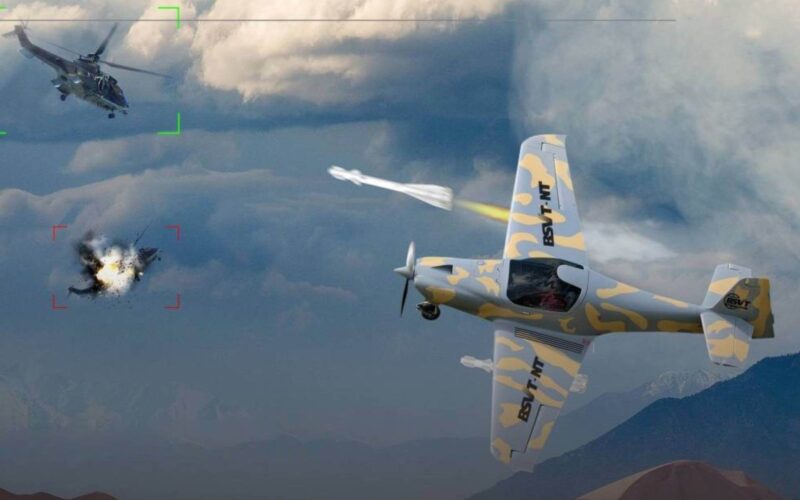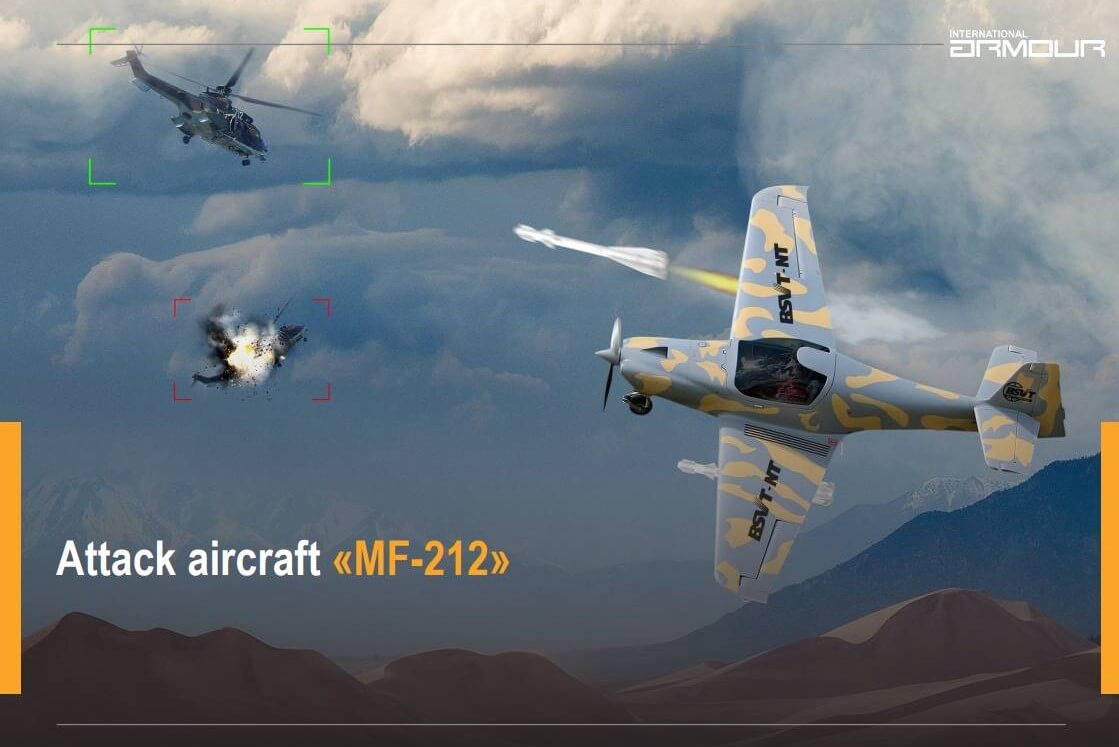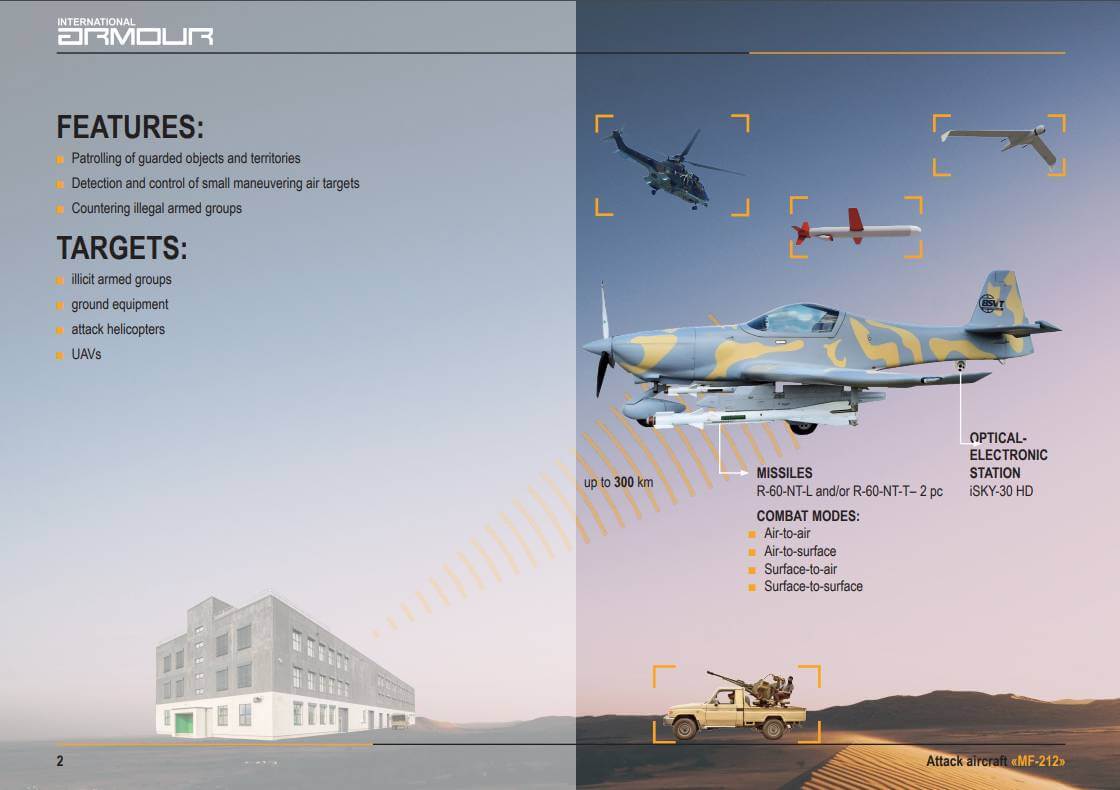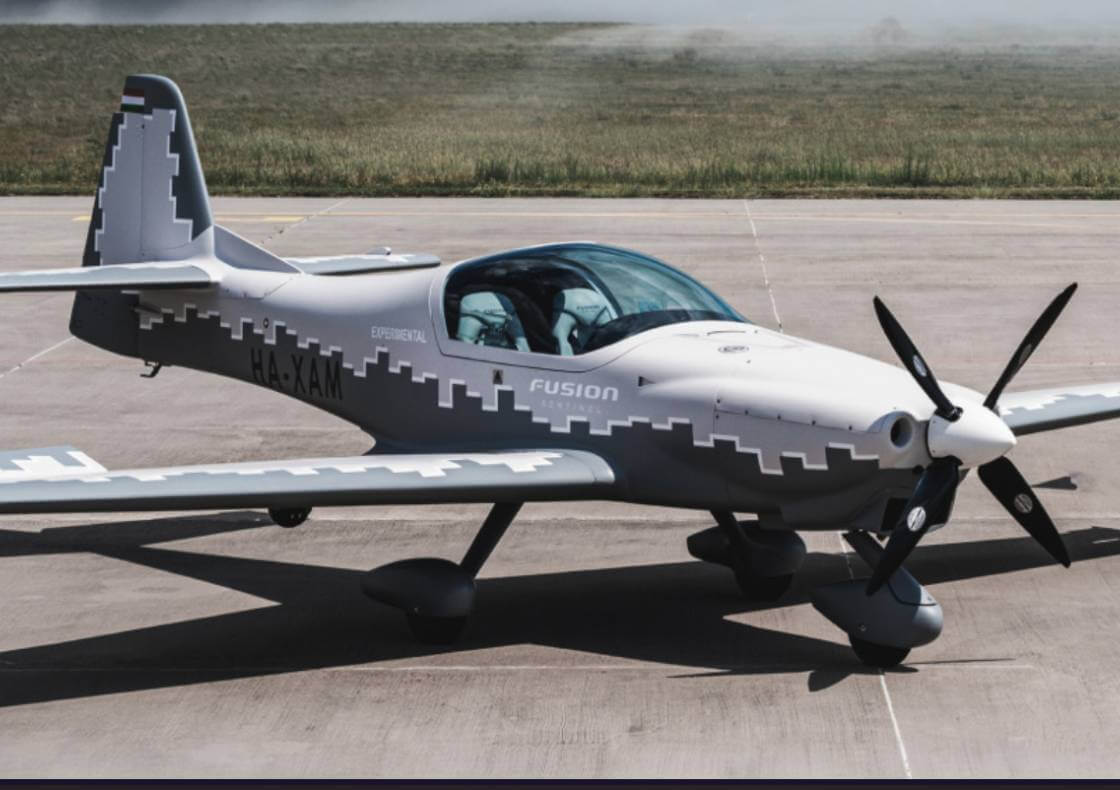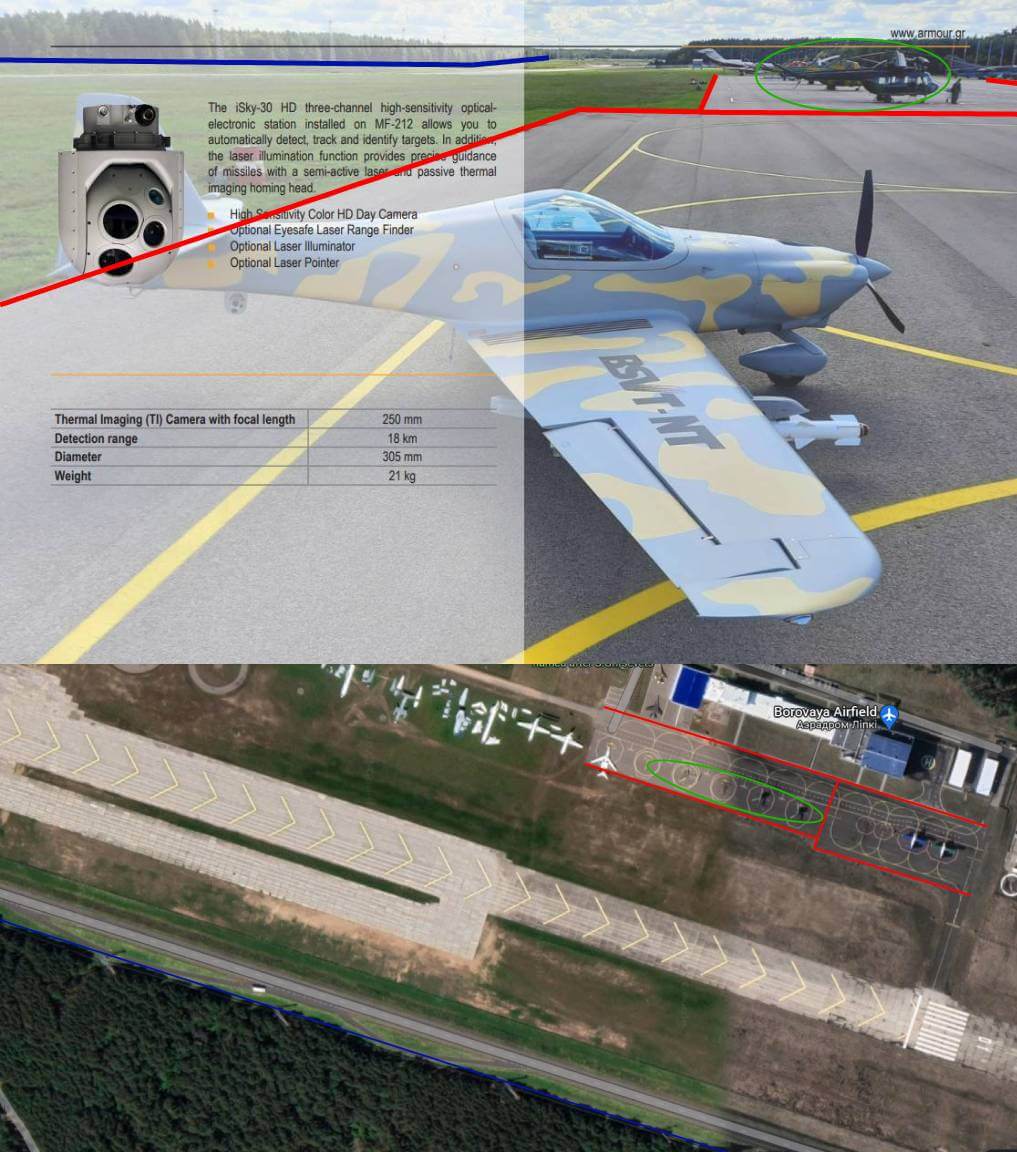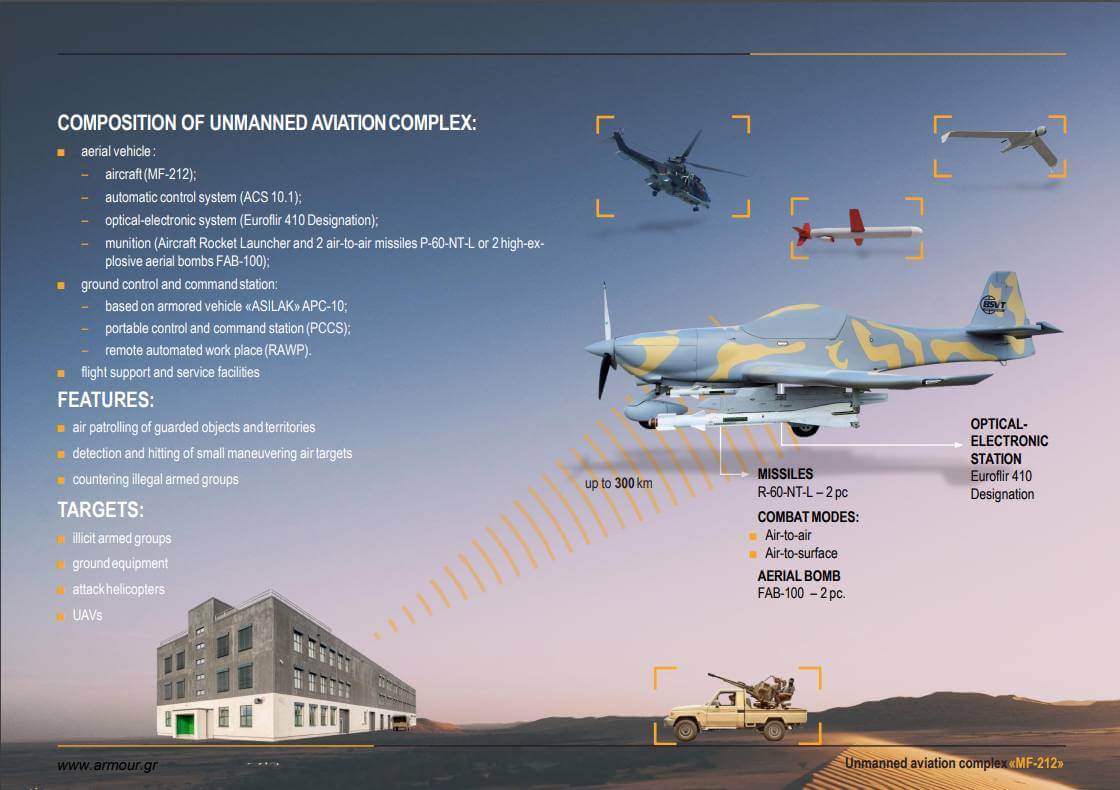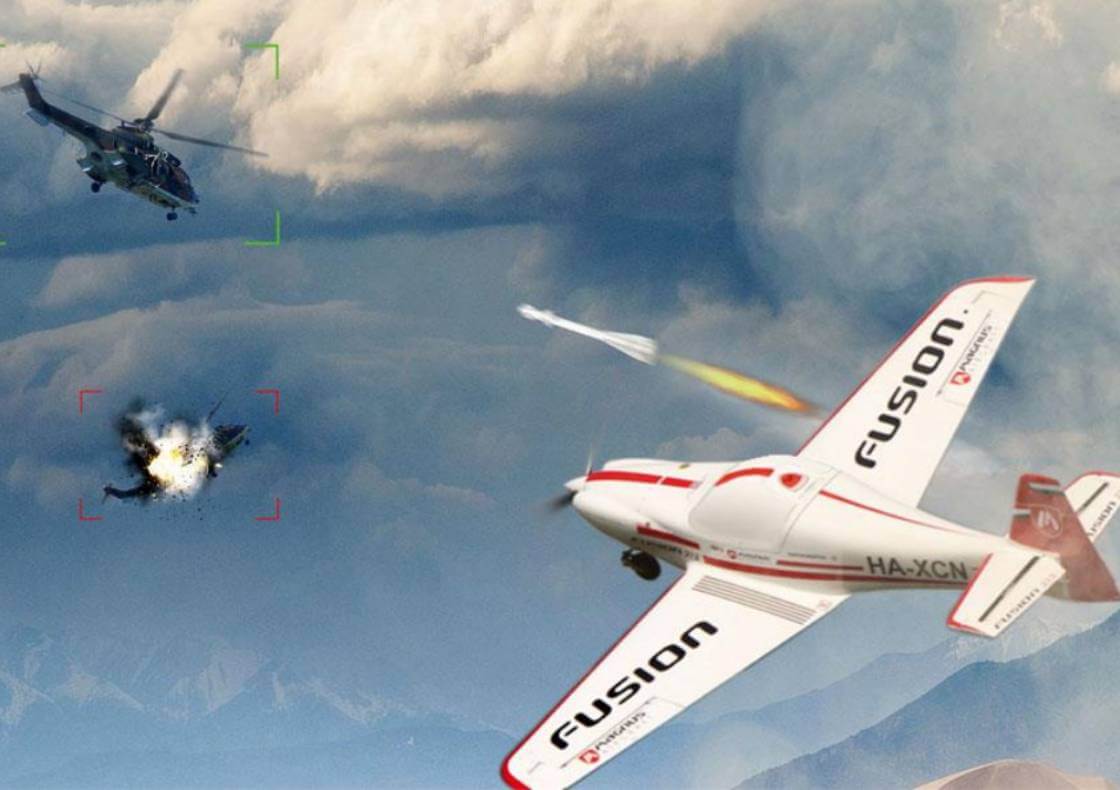The history of aviation is full of projects that lead to the question: what were they thinking?
Such projects might seem rare today, but once in a while they appear in obscure corners of the industry.
The MF-212 is one of these projects. The sales pitch presents it as a propeller-driven attack aircraft with the primary armament of air-to-air missiles.
In reality, it is a light sports aircraft that the Belarusian military seems to have tried to turn into an attack aircraft and an interceptor. And reportedly, it already has foreign customers.
Lots of questions
International Armour, a Greek company which claims to sell various kinds of defense and security products, has the MF-212 in its sales catalogue.
According to the company’s brochure, the aircraft’s features include “Patrolling of guarded objects and territories,” “Detection and control of small maneuvering air targets” and “Countering illegal armed groups”.
MF-212 brochure (Image: International Armour)
MF-212 brochure (Image: International Armour)
The tasks are performed with the help of two air-to-air missiles: “R-60-NT-L and/or R-60-NT-T”, as the brochure describes them. Additionally, the brochure claims that the aircraft is equipped with the Controp iSky-30HD surveillance system.
All of that adds up to a unique setup: a light propeller aircraft with air-to-air missiles as its primary armament, a contraption that has no comparisons in aviation history.
This – coupled with the aircraft’s features – raises lots of questions, to the point that it is difficult to discern how real the project actually is. AeroTime attempted to contact International Armour for a comment but the company did not respond. Additionally, immediately following AeroTime’s inquiry, parts of the sales catalogue at International Armour website became inaccessible. The brochure with the information about the aircraft, as well as company’s other brochures, are now accessible only via a direct link.
Extendable menu at the website of International Armour (screenshot taken on October 26, 2022). A number of categories, such as ”Pistols/Revolvers”, still open a catalogue of weapons the company claims selling. Some categories, such as ”Missiles & Rockets” and ”Combat Robots” no longer open.
In early October 2022, several African news websites reported that the MF-212 was included in the 2023 budget proposal of the Nigerian Army. While details were scarce, the reports noted that the aircraft was rejected by the Nigerian Air Force. AeroTime sent inquiries to the Nigerian Army and the Nigerian Air Force but, at the time of publishing, had received no responses.
Hungarian airframe
There are several other international connections that can be backed up with slightly higher degrees of certainty though.
The MF-212 appears to be based on the Fusion UL, also sometimes referred to as the Fusion 212 and Magnus Fusion: a light sporting aircraft manufactured by Hungary’s Magnus Aircraft.
“The Fusion UL is probably the sexiest aircraft you’ve ever encountered. It is the perfect blend of 21st century high-technology and excellence for those who never get satisfied with the ordinary or mediocre,” according to the description found in the Magnus Aircraft website.
Magnus Aircraft offers two engine options – for either 100 or 141 horsepower – giving the aircraft a maximum cruise speed of 256 km/h (122 kts) and fuel consumption of just 16-21 liters per hour (4.2-5.4 gallons per hour).
Interestingly, one of the engines offered – the Rotax 912 – is the same one used on the Turkish Bayraktar TB2 drone. The empty weight of the Fusion UL (300 kilograms) is smaller than the TB2 (420 kilograms), but the airplane also has to carry at least one pilot. Needless to say, the Fusion UL – built for sport – is also much more capable of aerobatics platform than the TB2.
In a comment received by AeroTime, Magnus Aircraft said it has no connection to International Armour and did not participate in the development of the MF-212 attack aircraft.
Furthermore, Magnus Aircraft manufactures its own surveillance version of the Fusion UL: the Fusion Sentinel. According to the company, it has a reinforced airframe and carries a remotely operated camera system.
The MF-212, as displayed in International Armour brochure, is seemingly not based on the Fusion Sentinel: it lacks reinforcing beams in the tail and its surveillance system is depicted as being in the tail instead of under a wing.
Magnus Fusion Sentinel. Note the reinforced vertical stabilizer and the surveillance station under the right wing (Image: Magnus Aircraft)
The likely Belarusian connection
While International Armour’s website says it is a Greek company and the Magnus Fusion is manufactured in Hungary, the there are some details that might link the MF-212 attack aircraft to Belarus.
The photos of the MF-212, included into the brochure, can be geolocated to Lipki Aerodrome, also known as Borovaya Airfield: a small military and civilian airport near Minsk, owned by the Belarusian Ministry of Emergency Situations. Note the markings on the ground (this spot in Google Maps), the lineup of helicopters and the forest in the background in the photo below.
The area where the photo for International Armour brochure was taken: Lipki Aerodrome, Belarus (Image: International Armour / AeroTime News; Map data: Google, CNES, Maxar Technologies)
The aircraft, portrayed in the brochure, also has ‘BSVT-NT’ inscribed on its wings. The acronym refers to Belspetsvneshtechnika: Belarusian state-owned Foreign Trade Unitary Enterprise which specializes in the “development, production and upgrade of armament and military equipment”.
The enterprise has its own sales catalogue which contains an array of military equipment employed by Belarusian Armed Forces: from T-72A and T-72M tanks to Belarusian-upgraded versions of Tochka ballistic missile to a variety of Soviet-era fighter jets and strike aircraft.
The MF-212 is absent from the catalogue. However, the acronym ‘NT’ in the name means that the aircraft was most likely developed by BSVT-New Technologies, BSVT’s subsidiary which does not have a publicly accessible catalogue and, according to its website, focuses on video processing systems, artificial intelligence and other high-tech developments.
AeroTime attempted to contact both BSVT and BSVT-NT. At the time of publishing, we have received no responses.
A closer look
With the companies behind the aircraft not responding, the only way to investigate if the project holds any water is to look at the available data.
The photos in the brochure portray a Magnus Fusion aircraft with a distinct yellow-gray camouflage and two missiles under the wings. The iSky-30HD surveillance station, visible in some photos, appears to be added in post-production, as the directions of the shadows on the station and the rest of the aircraft do not match.
The missiles, seen under the aircraft’s wings, belong to the R-60 family of short-range infrared-guided air-to-air missiles developed in the Soviet Union in the 1960s and 70s.
In 2020, the Belarusian government announced that BSVT-NT had developed a modernized variant of the R-60, called the R-60-NT. According to the announcement, the missile was equipped with a new guidance system and two kinds of targeting systems: a heat-seeking one and a laser-guided one.
The International Armour brochure mentions MF-212 being able to carry the R-60-NT-L missile capable of engaging targets marked by a laser designator and the R-60-NT-T missile with an infrared seeker. These two variants appear to correspond to the 2020 announcement.
The gray-colored tip of the missile, seen under the wings of the MF-212, suggests that the R-60-NT is based on the R-60M, an upgraded variant from the 1980s (the original R-60 has a black tip). The unmodified R-60M weighs 45 kilograms, while the APU-60-1DB missile rail weighs around 32 kilograms.
So, the whole missile setup weighs at least 154 kilograms. The maximum take-off weight of the Fusion UL is 600 kilograms and the empty weight is 299 kilograms, which means that at least in theory the aircraft could take off with the missiles. However, its fuel load would have to be very small indeed, and the pilot would presumably have to be of a light weight too.
There are no photos or videos of the MF-212 with the missiles being airborne. The aircraft, portrayed in the International Armour brochure, is the Magnus Fusion 212 reg. EW-496AS, belonging to a Belarusian paramilitary organization called DOSAAF: “The Voluntary Society of Assistance to the Army, the Air Force and the Navy of the Republic of Belarus.”
The aircraft has been stationed at Lipki since at least since 2020. In 2021, the plane was given to the Belarusian State Aviation Academy. By that time the tail of the aircraft was adorned with the Belarusian flag, and the registration number had been inscribed on the side of the fuselage in large letters. There are no traces of missiles under the aircraft’s wings in photos from 2021.
So, the aircraft, depicted in the MF-212 brochure, was a regular Magnus Fusion used for training. It continued in this role after the photos for the brochure were taken.
Alleged robotic versions
International Armour also claims to sell two unmanned versions of the aircraft: the Unmanned Aviation Complex MF-212 and the Lightweight multi-purpose aircraft Magnus Fusion.
The brochure of the former of them shows the same Magnus Fusion UL reg. EW-496AS with its canopy covered.
The aircraft is also described as carrying the Safran Euroflir 410 airborne electro-optical system (a picture of it is inserted into the photo) and the Automatic Control System ACS 10.1. While there are no references to such a system elsewhere on the internet, the pictures in the brochure are similar to the pictures of the SAU-9.0 Mini automatic control system, which is present in the catalogue of BSVT and used on some Belarusian-made military drones.
The ‘Lightweight multi-purpose aircraft Magnus Fusion’ brochure depicts two Magnus Fusion aircraft – one of them reg. HA-XCN (a prototype owned by Magnus Aircraft) and the other one reg. I-C505 (owned by Bielsko-Bialski aeroclub from Poland) with their canopies covered, add the iSky-30HD surveillance station and two R-60M missiles.
Unmanned Aviation Complex MF-212 brochure (Image: International Armour)
Lightweight multi-purpose aircraft Magnus Fusion brochure (Image: International Armour)
So, is it real?
In theory, the MF-212 attack aircraft probably could take off. However, there is no indication that an actual combat version of the Magnus Fusion has ever been flown: there is no proof of the aircraft with missiles taking off in Belarus, and its optical station appears to be added with a little help from photo editing software.
The same software appears to have been used to create two unmanned versions of the aircraft too. The only prototype of the MF-212 – if we can call it that – appears to have never been fitted with remote control equipment or surveillance stations and is a training aircraft that belonged to a Belarusian paramilitary organization.
That does not mean that the concept is baseless. Light attack aircraft exist, although they are usually manufactured by modifying considerably heavier and more robust airplanes: for example, US Special Forces use the AT-802U Sky Warden, based on the Air Tractor AT-802 which weighs ten times more than the Magnus Fusion and can carry tens of times more payload.
The selection of the Magnus Fusion for the conversion raises another problem. Since the start of Russia’s full-scale invasion of Ukraine the European Union has imposed a range of sanctions on Belarus.
The sanctions include dual-use goods and technologies. There is a question whether sports aircraft fit under those sanctions, but at least some of the equipment – such as the French-made Euroflir 410 optical system – certainly does.
The photos for the International Armour catalogue were taken before 2021, at a time when the sanctions were not as harsh and international sales of such aircraft might have been possible. However, that is no longer the case.
Many questions remain: why was this project created, how did it make its way into International Armour catalogue, and was it ever seriously considered for production? Without the comments from the people behind the MF-212, these questions will forever remain unanswered.

